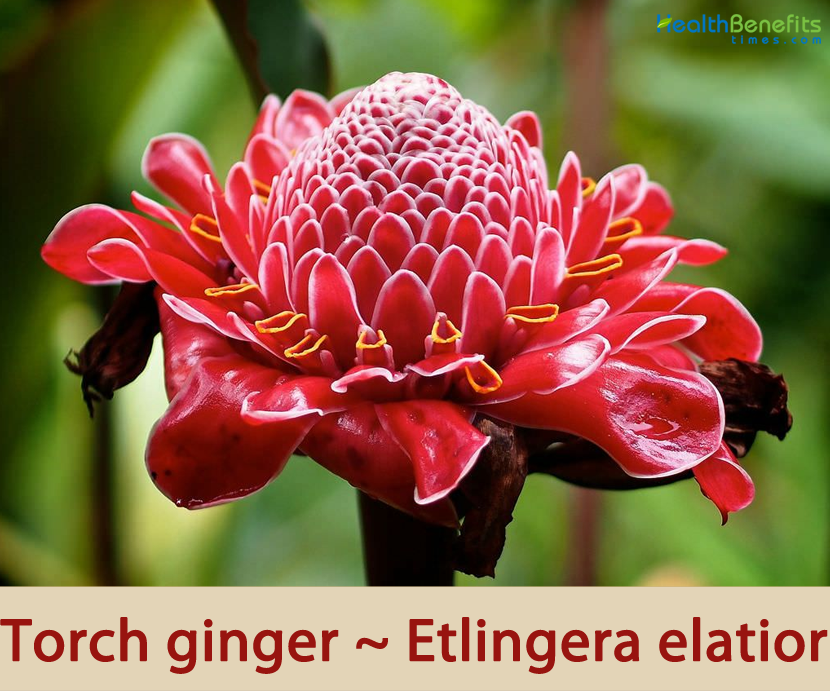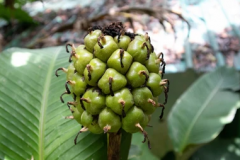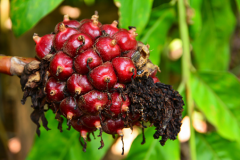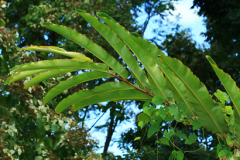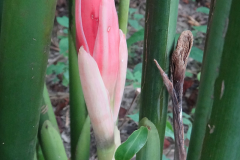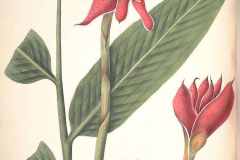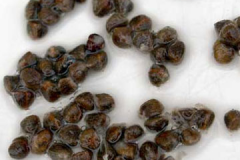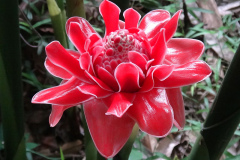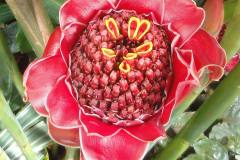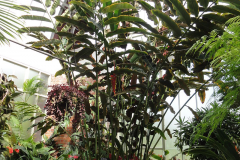Some of the well-known common names of the plants are Torch Ginger, Ginger Flower, Red Ginger Lily, Torch Lily, Wild Ginger, Wax Flowers, Combrang, Bunga Siantan, Philippine Wax Flower, Xiang Bao Jiaing, Indonesian Tall Ginger, Painted Net Leaf, Nerve Plant, Bunga Kantan, boca de dragón, rose de porcelaine, Rojak Flowers and porcelain rose. Genus name honors Andreas Ernst Etlinger, 18th century botanist. Specific epithet comes from the Latin word elatus meaning tall, which refers to the plant height. The plant is used locally as a food, condiment, medicine, and ornament. It is very widely grown as an ornamental in the tropics and in greenhouses in the temperate zone, being valued especially for its spectacular flowering display. In the modern-day, Torch Ginger flowers are widely incorporated as a staple flavoring in Southeast Asian dishes, and the entire plant, including the seeds, flowers, and leaves, are edible. Torch Ginger plants are also one of the most commercialized tropical flower varieties for decorative flower arrangements and backyard landscapes.
Torch Ginger Facts
| Torch ginger Quick Facts | |
|---|---|
| Name: | Torch ginger |
| Scientific Name: | Etlingera elatior |
| Origin | Tropical Africa but is also found in the Philippines, Indonesia, Malaysia, and southern Thailand |
| Colors | Initially green when unripe, turning to red at maturity |
| Shapes | Berry-like, globose, 2-2.5 cm in diameter, with silky hairs |
| Health benefits | Clean the blood, Overcoming body odor, Launch breast milk, Solve skin problems, Make bones and teeth strong, Prevent dehydration, Improve brain function, Treat wounds, Neutralize stomach acid, As a diet menu |
| Name | Torch ginger |
|---|---|
| Scientific Name | Etlingera elatior |
| Native | Tropical Africa but is also found in the Philippines, Indonesia, Malaysia, and southern Thailand. It is distributed throughout South-east Asia, New Guinea, the Bismarck Archipelago, the Philippines, Australia (Queensland) and Polynesia. However, the species is widely cultivated and can be found naturalized in tropical and subtropical regions worldwide |
| Common Names | Torch Ginger, Ginger Flower, Red Ginger Lily, Torch Lily, Wild Ginger, Combrang, Bunga Siantan, Philippine Wax Flower, Xiang Bao Jiaing, Indonesian Tall Ginger, Painted Net Leaf, Nerve Plant, Bunga Kantan, boca de dragón, rose de porcelaine, and porcelain rose |
| Name in Other Languages | Chinese: Xiang bao jiang, Xiang hua ya jiang, huo ju jiang (火炬姜) Colombia: Bastón del Obispo, bastón del rey, heliconia bastón Costa Rica: Bastón de emperador English: Ginger bud, Javanese aromatic ginger, Indonesian tall ginger, Pink ginger bud, Torch ginger, Torch ginger flower buds, Nicola flower buds, Philippine waxflower, porcelain flower, Porcelain Rose, Siam Rose, Torch Lily French: Gingembre aromatique, Gingembre aromatique de Java, Gingembre aromatique des Malais, awapuhi, opuhi, rose de porcelain German: Fackelingwer, Kaiserzepter Indonesia: Bunga kecombrang, honge, kecombrang Japanese: Tōchijinjā (トーチジンジャー) Javanese: Kecombrang Latvian: Malajas laterningvers Malay: Kantan, Bunga kantan, Bunga siantan, Honje (Indonesia), Kecombrang Malaysia: Bunda kantan, kantan Minangkabau: Kincong Portuguese: Rosa-de-porcelana, Bastão-do-imperador Puerto Rico: Antorcha Spanish: Boca de dragon, flor de cera Sundanese: Honjé Swedish: Fackelingefära Tahitian: Opuhi ra’ura’a pa’ari Thai: Kaa laa, Dā h̄lā (ดาหลา) USA: Awapuhi ko‘oko‘o |
| Plant Growth Habit | Large, erect, tropical, fast-growing, evergreen, herbaceous, rhizomatous perennial plant |
| Growing Climates | Grows in primary and secondary forest, forest edges, disturbed areas, secondary vegetation near villages and along roadsides |
| Soil | Can tolerate a variety of soil types, the plants thrive in organically rich soil with sharp drainage. They prefer a slightly acidic to neutral soil pH |
| Plant Size | Leafy stems up to 6 meters tall and flowering stems about 60 – 100 cm tall |
| Rhizomes | Rhizomes are stout (3-4 cm in diameter), strongly aromatic and found just below ground level |
| Leaf | Leaves are numerous, 15-30, arranged alternately in one shoot. Lower leaf is smaller than upper leaf. Lamina is elliptic to lanceolate, mostly oblong, measuring 38 – 85 cm long and 8 – 18 cm wide, shiny green, pale green beneath and glabrous. |
| Flower | Inflorescence is borne on long, slender, and leafless peduncle arising from the rhizome. Flower head is large and surrounded by large, red, involucrate bracts |
| Fruit Shape & Size | Berry-like, globose, 2-2.5 cm in diameter, with silky hairs |
| Fruit Color | Initially green when unripe, turning to red at maturity |
| Propagation | By rhizome fragments, but sometimes by seed as well |
| Plant Parts Used | Rhizomes, stems, leaves, fruits, flowers and essential oils |
| Health Benefits |
|
Plant Description
Torch ginger is a large, erect, tropical, fast-growing, evergreen, rhizomatous perennial plant that grows in large clumps of erect, leafy stems up to 6 meters tall and flowering stems about 60 – 100 cm tall in tropical climates but much shorter in cooler climates. The plant is found growing in primary and secondary forest, forest edges, disturbed areas, and secondary vegetation near villages and along roadsides. The plant can tolerate a variety of soil types, the plants thrive in organically rich soil with sharp drainage. They prefer a slightly acidic to neutral soil pH. Rhizomes are stout (3-4 cm in diameter), strongly aromatic and found just below ground level. Stems are sometimes sliced into small pieces and added to curries and soups.
Leaves
Leaves are numerous, 15-30, arranged alternately in one shoot. Lower leaf is smaller than upper leaf. Lamina is elliptic to lanceolate, mostly oblong, measuring 38 – 85 cm long and 8 – 18 cm wide, shiny green, pale green beneath and glabrous. Young leaves are yellowish green and the lower surface is often purplish; margins wavy; base varies rounded too cordate, sometime unequal; apex acuminate. Sheath is green. Ligule is entire measuring 1.5 cm long, apex rounded, green. Petiole measures 1.5 – 4 cm long.
Flower
Inflorescence raised above the ground; ovoid shape and consist of flowers arranged spirally with base surrounded by involucral bract forming a flower cluster. Involucral bract is glabrous, obtuse, yellowish white at base, apex pale pink with the sub apical tooth. Receptacle 1.5 cm long and 1.2 cm wide and support 71 flowers that open simultaneously. Fertile bract is oblong, white to pale pink; apex with tufted hair margin, obtuse. Bracteole is entire, oblong, white to pale pink, more transparent than fertile bract. Calyx is white at base, apex pale pink with apical tufted white hairs. Corolla tube is white, inner surface covered with white hairs. Corolla lobe linear-elliptic, culcullate; white to pale pink at base, apex pink to red. Labellum 2–3 cm, red, margin bright yellow; lateral lobe higher than stamen, margin crinkled and recurved. Staminal tube is white, above the corolla tube. Anther is 0.8–0.9 cm long oblong, dorsal red, white at front, and hairs on pollen sacs. Filament is short and flat. Stigma is clavate (club-shaped), dark red; style 1.9–3 cm glabrous, white surrounded by the anther.
The brightly colored blooms have been utilized in ornamental, medicinal, and culinary preparations for centuries and are highly favored for their zesty, ginger-like flavoring. There are three main colors of Torch Ginger flowers, found in pink, red, and white shades, and the pink blooms are considered the most common in fresh markets. Torch Ginger flowers earned their name from their elongated stem and curved tapered flower, similar in appearance to a flaming torch.
Fruit
Fruiting head is subglobose, about 10-20 cm in diameter. Fruit is berry-like, globose, 2-2.5 cm in diameter, with silky hairs. Fruits are initially green when unripe, turning to red at maturity. Seeds are small, numerous, black-brown, with a white or pink, translucent aril.
Health benefits of Torch ginger
Based on latest research, the benefits of this plant for the human body are listed below:
1. Clean the blood
Dirty blood on the human body can cause problems in certain organs of the body. One effect is the onset of acne. This plant consists of natural compounds that can cleanse the blood. So the blood that flows does not carry bacteria or viruses. Clean blood makes a healthy body.
2. Overcoming body odor
If you have problems with body odor, you can use perfume made from this plant. Besides this is a natural way, the material is also easy to obtain and have the same properties. This can happen because the stem of this plant has a smell of fragrant. Thus stem can be used as a perfume to remove body odor.
3. Launch breast milk
Breast milk is considered one of the best food sources for new born babies. Consuming enough vegetables, fruits and also torch ginger help to get sufficient amount of breast milk. You can process it into a delicious meal or as a flavor to the cuisine.
4. Solve skin problems
Various skin problems can be overcome with Torch ginger plant. Skin problems are related with clean blood. Torch ginger plant help to clean the blood on the body and automatically problems that exist on your skin can also be lost.
5. Make bones and teeth strong
Torch ginger plant has a higher mineral content. Thus, this plant is excellent for making bone health and teeth strong. Consuming this plant is highly recommended particularly for children who are in its infancy.
6. Prevent dehydration
Dehydration is considered harmful for the body. Consume sufficient fluids so that the body does not dehydrate. Another way to keep body fluids lost due to action is to consume flowers from this plant. Because it consists of water and high mineral that can replace body fluids.
7. Improve brain function
The brain is the center of control in the human body. If the brain loses its function, then all the organs that are in the body will come into trouble as well. One way to improve brain function is to consume Torch ginger plant.
8. Treat wounds
Torch ginger plant consists of anti-microbial properties. It is quite effective for treating wounds so that the wound remains sterile and quickly healed. Compared to using chemical drugs, you better use the natural way of this plant.
9. Neutralize stomach acid
If you are suffering from problems with stomach acid then consuming Torch ginger plant regularly can neutralize your stomach acid. Apart from that you should also maintain a healthy diet like not eating too spicy or too sour food. Eating just in time can also keep stomach acid stable.
10. As a diet menu
Torch ginger plant consists of low fat. So it must be consumed by those who are on a diet program.
Traditional uses and benefits of Torch ginger
- In southeastern Asia, it is used in traditional medicine.
- Traditionally it is believed that a daily intake of the raw inflorescence can reduce diabetes and hypertension.
- In Malaysia, it is believed that the decoction of its fruits is used to treat earaches, while the decoction of the leaves is used for cleansing wounds.
- Leaves are also used by post-partum women and mixed with other aromatic herbs in water for bathing to remove body odor.
- In North Kolaka, Indonesia used for treatment of thyroid fever symptoms like mouth sores, diarrhea, coughs, and lack of appetite.
Culinary Uses
- In Southeast Asia, flowers, fruits, and young and tight buds are consumed by humans as spice in curries, fish soups, stir-fried vegetables and salads.
- The fruit is very sour but edible, and can be used in cooking.
- Less commonly, the hearts of young vegetative shoots are used for flavoring dishes or eaten raw with rice.
- Ripe fruits can be eaten raw or processed into sweets.
- In Malaysia it is used for flavoring ‘laksa’ (a special noodle dish) and many other local dishes.
- Immature flower buds of the Torch Ginger have a unique fragrance and taste which is mainly used in Singapore, Malaysia and Thailand.
- Some common dishes that use the flower bud are rojak and laksa.
- In Singapore and Malaysia, the bud is sometimes added to Peranakan fish curry.
- Raw bud is added to a salad called “khaao yam” or eaten with a spicy sauce in Thailand.
- In North Sumatra, the flower buds are used for a stewed fish dish called Arsik ikan mas.
- In Bali, people use the white part of the bottom part of the trunk for cooking chili sauce called Sambal Bongkot, and use the flower buds to make chili sauce called Sambal Kecicang.
- In Thailand, it is eaten in a kind of Thai salad preparation.
- In Malaysia, the flower is an essential ingredient in cooking the fish broth for a kind of spicy sour noodle soup called Asam Laksa, Nin the preparation of a kind of salad called Kerabu and many other Malay dishes.
- The fruit is also used in Indonesian cooking.
- Young and tight buds used for flavoring.
- It gives spice and color to curries, fish soups, stir-fried veggies and salads.
- Flower used in Southeast Asia for cooking, in salads and as soup garnish.
- Flower buds are an essential ingredient in the Karo version of the dish Sayur asam.
- Half-ripe fruits are also applied in cooking.
- Ripe fruits can be eaten raw, or processed into candies.
- Leaves can be cooked with rice.
- Young flower shoots and half-ripe fruiting shoots are used locally as a substitute for tamarind.
- It is used as a condiment in curries.
- Stalks of the inflorescence are chopped and added to laksa pots (various curries or soups made with rice noodles).
- Half-ripe fruits are eaten in soups and stews.
Other Facts
- Torch ginger is commonly planted as an ornamental and hedge plant.
- It is also cultivated on a commercial scale as a cut-flower in Hawaii and Australia.
- The stem is made into matting in Sumatra.
- The stems also have potential as raw material for the manufacture of paper.
- The rhizome is reported to yield a yellow dye.
- It is widely cultivated and introduced as an ornamental plant in gardens in the tropical regions.
- It is cultivated for cut flowers in Hawaii and Australia.
- It is used as ingredient for making soap, shampoo, and perfumes.
- Flower yields a dye caused by an anthocyanidin flavonoid.
References:
https://www.itis.gov/servlet/SingleRpt/SingleRpt?search_topic=TSN&search_value=502458#null
https://npgsweb.ars-grin.gov/gringlobal/taxon/taxonomydetail?id=409477
https://www.cabi.org/isc/datasheet/109802
https://www.missouribotanicalgarden.org/PlantFinder/PlantFinderDetails.aspx?taxonid=291516
https://gd.eppo.int/taxon/NCLEL
https://www.nparks.gov.sg/florafaunaweb/flora/1/9/1990
http://www.theplantlist.org/tpl1.1/record/kew-244696
https://en.wikipedia.org/wiki/Etlingera_elatior
http://www.flowersofindia.net/catalog/slides/Torch%20Ginger.html
https://indiabiodiversity.org/species/show/229674
http://www.stuartxchange.com/TorchGinger.html
http://tropical.theferns.info/viewtropical.php?id=Etlingera+elatior
https://plants.usda.gov/home/plantProfile?symbol=ETEL


